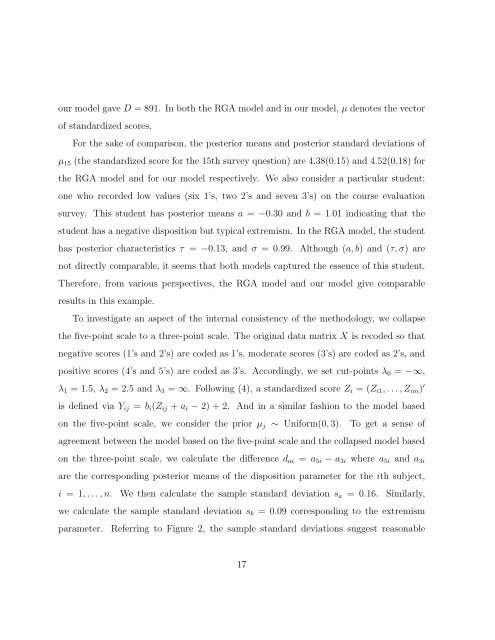Bayesian analysis of ordinal survey data using the Dirichlet process ...
Bayesian analysis of ordinal survey data using the Dirichlet process ...
Bayesian analysis of ordinal survey data using the Dirichlet process ...
Create successful ePaper yourself
Turn your PDF publications into a flip-book with our unique Google optimized e-Paper software.
our model gave D = 891. In both <strong>the</strong> RGA model and in our model, µ denotes <strong>the</strong> vector<strong>of</strong> standardized scores.For <strong>the</strong> sake <strong>of</strong> comparison, <strong>the</strong> posterior means and posterior standard deviations <strong>of</strong>µ 15 (<strong>the</strong> standardized score for <strong>the</strong> 15th <strong>survey</strong> question) are 4.38(0.15) and 4.52(0.18) for<strong>the</strong> RGA model and for our model respectively. We also consider a particular student;one who recorded low values (six 1’s, two 2’s and seven 3’s) on <strong>the</strong> course evaluation<strong>survey</strong>. This student has posterior means a = −0.30 and b = 1.01 indicating that <strong>the</strong>student has a negative disposition but typical extremism. In <strong>the</strong> RGA model, <strong>the</strong> studenthas posterior characteristics τ = −0.13, and σ = 0.99. Although (a, b) and (τ, σ) arenot directly comparable, it seems that both models captured <strong>the</strong> essence <strong>of</strong> this student.Therefore, from various perspectives, <strong>the</strong> RGA model and our model give comparableresults in this example.To investigate an aspect <strong>of</strong> <strong>the</strong> internal consistency <strong>of</strong> <strong>the</strong> methodology, we collapse<strong>the</strong> five-point scale to a three-point scale. The original <strong>data</strong> matrix X is recoded so thatnegative scores (1’s and 2’s) are coded as 1’s, moderate scores (3’s) are coded as 2’s, andpositive scores (4’s and 5’s) are coded as 3’s. Accordingly, we set cut-points λ 0 = −∞,λ 1 = 1.5, λ 2 = 2.5 and λ 3 = ∞. Following (4), a standardized score Z i = (Z i1 , . . . , Z im ) ′is defined via Y ij = b i (Z ij + a i − 2) + 2. And in a similar fashion to <strong>the</strong> model basedon <strong>the</strong> five-point scale, we consider <strong>the</strong> prior µ j ∼ Uniform(0, 3). To get a sense <strong>of</strong>agreement between <strong>the</strong> model based on <strong>the</strong> five-point scale and <strong>the</strong> collapsed model basedon <strong>the</strong> three-point scale, we calculate <strong>the</strong> difference d ai = a 5i − a 3i where a 5i and a 3iare <strong>the</strong> corresponding posterior means <strong>of</strong> <strong>the</strong> disposition parameter for <strong>the</strong> ith subject,i = 1, . . . , n. We <strong>the</strong>n calculate <strong>the</strong> sample standard deviation s a = 0.16. Similarly,we calculate <strong>the</strong> sample standard deviation s b = 0.09 corresponding to <strong>the</strong> extremismparameter. Referring to Figure 2, <strong>the</strong> sample standard deviations suggest reasonable17
















